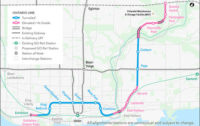After years of wrangling, excavation work on both sides of what is set to be the world’s longest underwater immersed-tube road and rail tunnel—an 18-km structure beneath the Baltic Sea between Germany and Denmark—finally got underway, with start of heavy construction on the German side in early December. The projected completion of the Fehmarnbelt Tunnel in 2029 will cut rail travel between Copenhagen and Hamburg to 2.5 hours, with trains set to travel at 200 km per hour.
Opposition has delayed the estimated $8.21-billion project for more than a decade, leading up to the German launch on the island of Fehmarn, which follows work getting underway in early 2021 on the Danish island of Lolland. Project opponents had kept lawsuits proceeding, with a court In Leipzig last year rejecting the final challenge to construction start. Site preparation for the German side excavation began at the end of March.
Environmental advocates raised concerns about marine life impact and ferry operators claimed that tunnel traffic volume would never justify project cost or its support with European public funding.
“The Fehmarnbelt Tunnel will be one of the largest and most important transport infrastructure projects in this decade,” said Enak Ferlemann, German parliament member and federal transport ministry official, in announcing the construction major start.
When finished, the tunnel will be assembled into an 18 km-long trench—100 m wide and 12 m deep—between the two islands. Tunnel tubes will shelter rail and road conduits under the Fehmarnbelt, which is the Baltic strait between the islands.
The project is pressing ahead on several fronts. On the Danish side, building has been underway since June 2020 on the working harbor at Rødbyhavn. On the German side, workers recently began sinking granite blocks off the Fehmarn coastline at Puttgarden to build a containment dam that will become the northern boundary of the tunnel portal's excavation pit, project spokeswoman Denise Juchem said. The dam is being built in shallow water just east of the current ferry terminal and its long protective retaining harbor wall.
The tunnel itself will be made from 79 standard elements—each about 42 m wide, 10 m tall and 217 m long, weighing 73,000 tonnes—with entire sections needing casting in a single pour to ensure they are watertight.
Juchem says the Fehmarnbelt Tunnel’s length alone makes it a unique engineering job, with most of construction materials and components to be delivered by sea to minimize stress on the local road network.
Progress continues in erecting the factory on the Danish side to manufacture the tunnel elements: the plant foundation now is in place and steel framing is underway for the first of what will be three production areas.
The Fehmarnbelt dredging operation will continue at a strong pace, with Dutch contractors Boskalis International B.V. and Van Oord Dredging and Marine Contractors B.V. managing more than 60 working craft, including Magnor, the world's largest dredger. It has a bucket that can lift 40 cu m—about the volume of a 20-foot shipping container—at a time. The Danish unit of Sweden-based SWECO is excavation adviser.
The rail link is part of a broad vision for European transport infrastructure, that would include a Scandinavian-Mediterranean corridor running from Stockholm to Sicily. Danish transport minister Benny Engelbrecht said he wants to ensure that every major European city can be reached by night train from Scandinavia. “We need to make sure people switch from short-haul flights to international train connections,” he said.
The project has been in planning for more than a decade, with a treaty signed in 2008 for a fixed link. Construction was originally anticipated to begin in 2015 with opening in 2021.
The project will have a workforce of 2,000 employees at the peak of activity, officials say.
Vinci Construction Grands Projets is lead contractor for two contracts covering construction of the immersed tunnel and tunnel precast element factory, with Per Aarsleff Holding as lead contractor for the tunnel access ramps. Also part of the construction team is Soletanche Bachy International, a Vinci subsidiary; CFE, Dredging International NV, Wayss & Freytag Ingenieurbau, Max Bögl Stiftung & Co, Bam Infra and Bam International. Project consultant is COWI.





Post a comment to this article
Report Abusive Comment